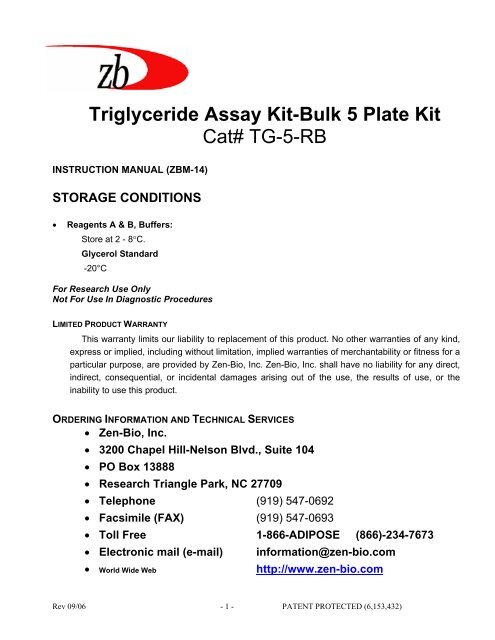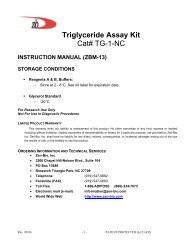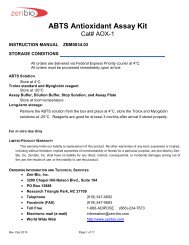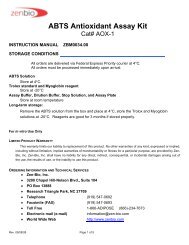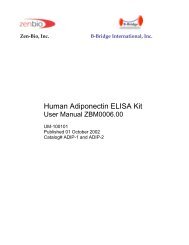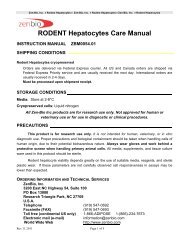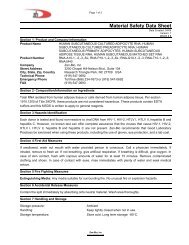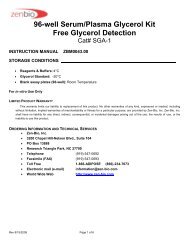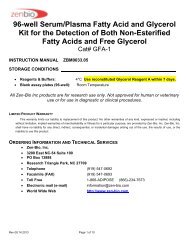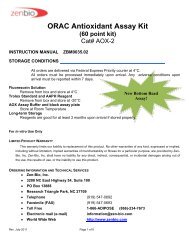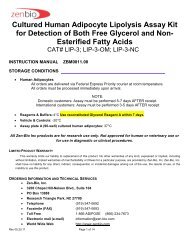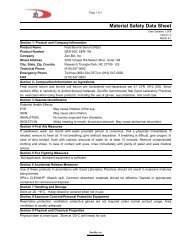Triglyceride Assay Kit-Bulk 5 Plate Kit Cat# TG-5-RB - Zen-Bio Inc.
Triglyceride Assay Kit-Bulk 5 Plate Kit Cat# TG-5-RB - Zen-Bio Inc.
Triglyceride Assay Kit-Bulk 5 Plate Kit Cat# TG-5-RB - Zen-Bio Inc.
You also want an ePaper? Increase the reach of your titles
YUMPU automatically turns print PDFs into web optimized ePapers that Google loves.
<strong>Triglyceride</strong> <strong>Assay</strong> <strong>Kit</strong>-<strong>Bulk</strong> 5 <strong>Plate</strong> <strong>Kit</strong><strong>Cat#</strong> <strong>TG</strong>-5-<strong>RB</strong>INSTRUCTION MANUAL (ZBM-14)STORAGE CONDITIONS• Reagents A & B, Buffers:Store at 2 - 8°C.Glycerol Standard-20°CFor Research Use OnlyNot For Use In Diagnostic ProceduresLIMITED PRODUCT WARRANTYThis warranty limits our liability to replacement of this product. No other warranties of any kind,express or implied, including without limitation, implied warranties of merchantability or fitness for aparticular purpose, are provided by <strong>Zen</strong>-<strong>Bio</strong>, <strong>Inc</strong>. <strong>Zen</strong>-<strong>Bio</strong>, <strong>Inc</strong>. shall have no liability for any direct,indirect, consequential, or incidental damages arising out of the use, the results of use, or theinability to use this product.ORDERING INFORMATION AND TECHNICAL SERVICES• <strong>Zen</strong>-<strong>Bio</strong>, <strong>Inc</strong>.• 3200 Chapel Hill-Nelson Blvd., Suite 104• PO Box 13888• Research Triangle Park, NC 27709• Telephone (919) 547-0692• Facsimile (FAX) (919) 547-0693• Toll Free 1-866-ADIPOSE (866)-234-7673• Electronic mail (e-mail)• World Wide Webinformation@zen-bio.comhttp://www.zen-bio.comRev 09/06 - 1 - PATENT PROTECTED (6,153,432)
<strong>Triglyceride</strong> <strong>Assay</strong> <strong>Kit</strong>-<strong>Bulk</strong> 5 <strong>Plate</strong> <strong>Kit</strong>(<strong>Cat#</strong> <strong>TG</strong>-5-<strong>RB</strong>)Items included in the kit:The contents of this kit are sufficient for the assay of up to 5 96 well plates. The protocol isdesigned for assay of cells in a 96-well format. For other formats, please adjust the volumesadded to each well according to the surface area of the well/flask you are using. See yourcultureware manufacturer’s technical information for the specifications.Item Instructions Amount StorageQTYWash Buffer 250ml 1 4°CLysis Buffer 125ml 1 4°CReagent AReconstitute w/ 40 ml deionized water.Reconstitute w/ 11 ml deionized water.Combine and mix before use.40ml11ml114°CReagent BReconstitute w/ 10 ml deionized water.Reconstitute w/ 2.5 ml deionized water.10ml2.5ml114°CCombine and mix before use.GlycerolstandardStandardsDiluentGlycerol @ 1mM [Reconstitute with 200 µlStandards Diluent to make the 200 µMglycerol standard; see manual forrecommended dilution scheme]50 µl 5 -20°C10 ml 1 4°COther equipment/reagents required but not provided with the kit: Single-channel pipetter Multi-channel pipetter <strong>Plate</strong> reader with a filter of 540 nmRev 09/06 - 2 - PATENT PROTECTED (6,153,432)
PROTOCOL1. Warm the Wash buffer and Lysis buffer in a 37 o C water bath.2. Prepare the Reagent B by adding 10ml and 2.5 ml deionized water to the labeledbottles and gently invert. DO NOT VORTEX! Use a pipet to insure that the powder iscompletely dissolved. Keep at room temperature. Store in a light protected bottle.Reconstituted Glycerol Reagent B is stable for 60 days refrigerated (2-8°C); store anyremaining solution refrigerated (2-8°C).3. Remove all media from mature human adipocytes. Using about 15 ml of the washbuffer, wash the cells one time with 150 µl wash buffer. Label the disposable tray “washbuffer” and retain for later use.4. Remove all wash buffer. Using a new tray, add 15 µl Lysis buffer per well. <strong>Inc</strong>ubate at37 o C - 50 o C for 20 minutes.5. After the incubation is complete, visually confirm cell lysis by checking the wells under amicroscope.6. Add 135 µl wash buffer to each well.7. Add 20 µl Reagent B to each well. It is not necessary to mix at this time, however,gently tap plate to mix reagents. <strong>Inc</strong>ubate the plate at 37 o C for 2 hours.8. One hour prior to the assay, bring the glycerol standard and Reagent B to roomtemperature. Warm the Standards Diluent to 37°C. Prepare the standard curve asfollows:Pipette 200 µl of the Standards Diluent into the 1 mM glycerol standard tubeprovided and mix well by vortexing. This produces a diluted stock glycerolstandard of 200 µM. Pipette 125 µl of Diluent into 6 tubes (not provided). Usingthe newly diluted stock glycerol solution, prepare a dilution series as depictedbelow. Mix each new dilution thoroughly before proceeding to the next. The 200Rev 09/06 - 3 - PATENT PROTECTED (6,153,432)
200 µl 125 µl 125 µl 125 µl 125 µl 125 µl 125 µlDiluentStd200 100 50 25 12.5 6.25 3.125µM µM µM µM µM µM µMµM stock dilution serves as the highest standard, and the Diluent serves as thezero standard.9. Also at this time prepare the Reagent A by adding 11 ml and 40 ml deionized water thelabeled bottles and gently invert. DO NOT VORTEX! Use a pipet to insure that thepowder is completely dissolved. Keep at room temperature. If using a Reagent Asolution previously prepared and stored at 2-8°C, also bring to room temperature. Makesure there is enough Reagent A from one solution to treat all the points in the assay. Itmay be necessary to combine solutions. Store in a light protected bottle. ReconstitutedGlycerol Reagent A is stable for 60 days refrigerated (2-8°C); store any remainingsolution refrigerated (2-8°C).10. To a blank 96 well plate, add 80 µl wash buffer to each well needed for the assay(NOTE: do not add Wash Buffer to the wells used for the standard curve).11. Working with one row or column at a time, mix the lysates very well using a multichannelpipet. Immediately transfer 20 µl per well of the lysates to the correspondingwell of the plate containing the wash buffer. This results in a Dilution Factor of 5.12. Prepare the standard curve. Pipet 100 µl of each standard into a well. (NOTE: Eightwells are necessary for the curve. If there are remaining wells on the assay plate, youcan utilize the remaining wells. If not, a second plate is included in this kit).13. Using the third tray, add 100 µl Reagent A to samples and standards. Mix by pipettingup and down one time. <strong>Inc</strong>ubate at room temperature for 15 minutes.14. Read at 540 nm using a microtiter plate reader.Rev 09/06 - 4 - PATENT PROTECTED (6,153,432)
DATA ANALYSISThis kit is designed to show relative lipid accumulation of experimental treatments compared tocontrols. The assay is based on the equation1 M <strong>Triglyceride</strong> yields 1M glycerol + Free Fatty AcidsThe reagent measures the concentration of glycerol released after lysing the cells andhydrolyzing the triglyceride molecules. The triglyceride concentration can then be determinedfrom the glycerol values.Generate standard curve: see example below[DO NOT use this standard curve to generate your data. This is an example.]Subtract the OD value of the 0µM standard from all OD values including the standard curve.Zero(blank) = .040µMOD -blankGlycerol OD3.125 0.054 0.0146.25 0.066 0.02612.5 0.082 0.04225 0.138 0.09850 0.214 0.174100 0.402 0.362200 0.711 0.671slope = 0.0034intercept= 0.0075r 2 = 0.9985OD0.80.60.40.20.0Standard Curvey = 0.0034x + 0.0075R 2 = 0.99850 100 200 300Glycerol in uMy = observed O.D. minus the blankx = concentration of glycerol in µMTo calculate x for each y, (i.e. to change the observed O.D. into glycerol concentration) use thefollowing equation:y=(slope) times (x) plus intercepty=mx+b so x=(y-b)/mx=(y – 0.0075)/0.003 where 0.003= slope of the line and 0.0075= y intercept. Be careful toenter the proper sign for the y intercept value as it may be a negative number.Any OD values greater than the highest standard (200 µM) should be suspect. The compoundshould be re-assayed using a lower dose of the compound at treatment OR a dilute solution ofthe condition medium at the time of the assay.Rev 09/06 - 5 - PATENT PROTECTED (6,153,432)
The R 2 value should be equal or greater then 0.98 for the standard curve to be valid. AnyR 2 values below 0.98, must have the standard curve run again.Solve for the Total Glycerol concentration (i.e. total triglyceride concentration) for each OD.Remember to include the Dilution Factor in the equation. Data is expressed as µMGlycerol.NOTE: Any OD values that are negative after the blank is subtracted should be considered tobe 0 for the OD value. Also any OD values greater than the highest standard (200 µM) shouldbe suspect. The compound should be re-assayed using a lower dose of the compound attreatment OR a more dilute solution of the condition medium at the time of the assay.TROUBLESHOOTINGProblemHigh background or the triglyceridereagent turns a darker color beforethe assay begins.Edge effects<strong>Inc</strong>onsistent OD readingSuggestions• Use clean tray and tips• Change pipet tips frequently• Ensure a saturated humidity in the incubatorto prevent evaporation from the outside wells• Be careful when pipetting to avoid bubbles. Ifbubbles persist, burst the bubbles using alarge gauge needle prior to reading and readthe plate again.• Mix the lysates well before transferring the20µl to the Wash buffer plate.REFERENCES1. Green, H. and Kehinde, O. (1974) Sublines of mouse 3T3 cells that accumulate lipid.Cell 1, 113-116.2. Hauner, H., et al., (1989) J. Clin. Invest.(84), 1663-1670.3. Kuri-Harcuch W, Wise LS, Green H. (1978) Interruption of the adipose conversion of3T3 cells by biotin deficiency: differentiation without triglyceride accumulation. Cell14:53-58.Rev 09/06 - 6 - PATENT PROTECTED (6,153,432)


